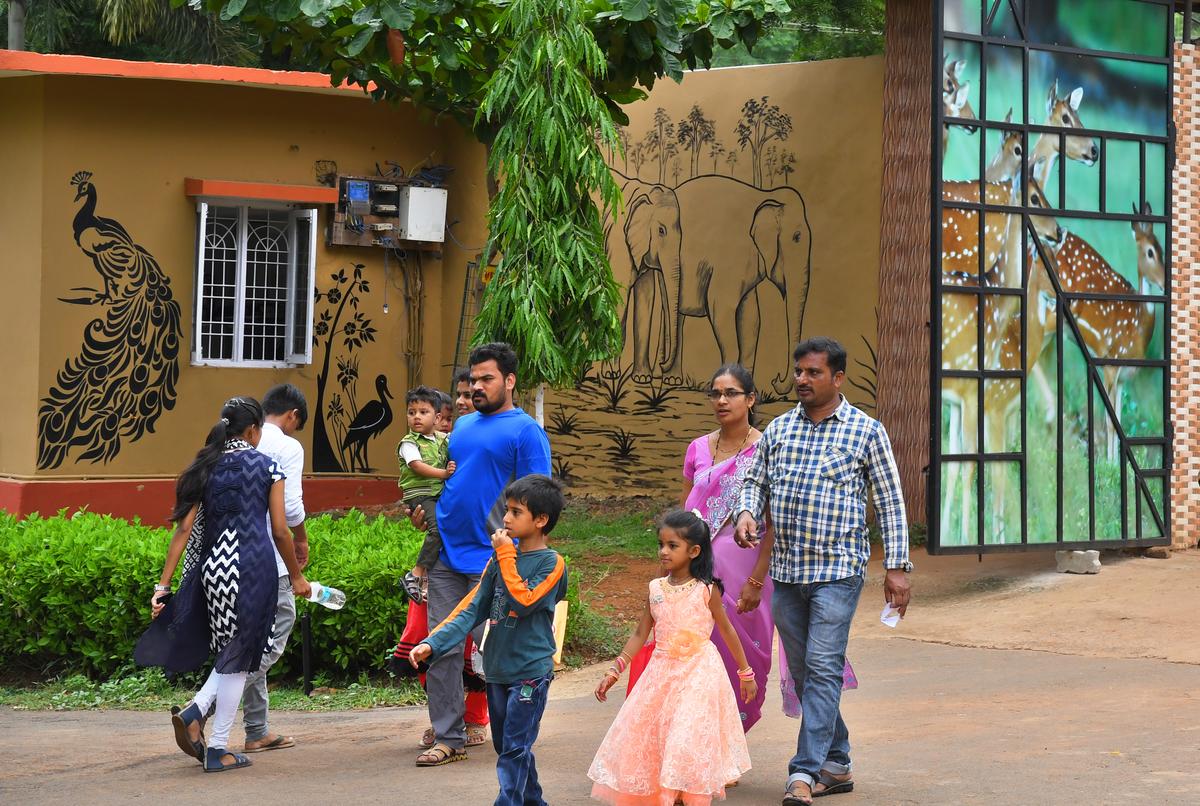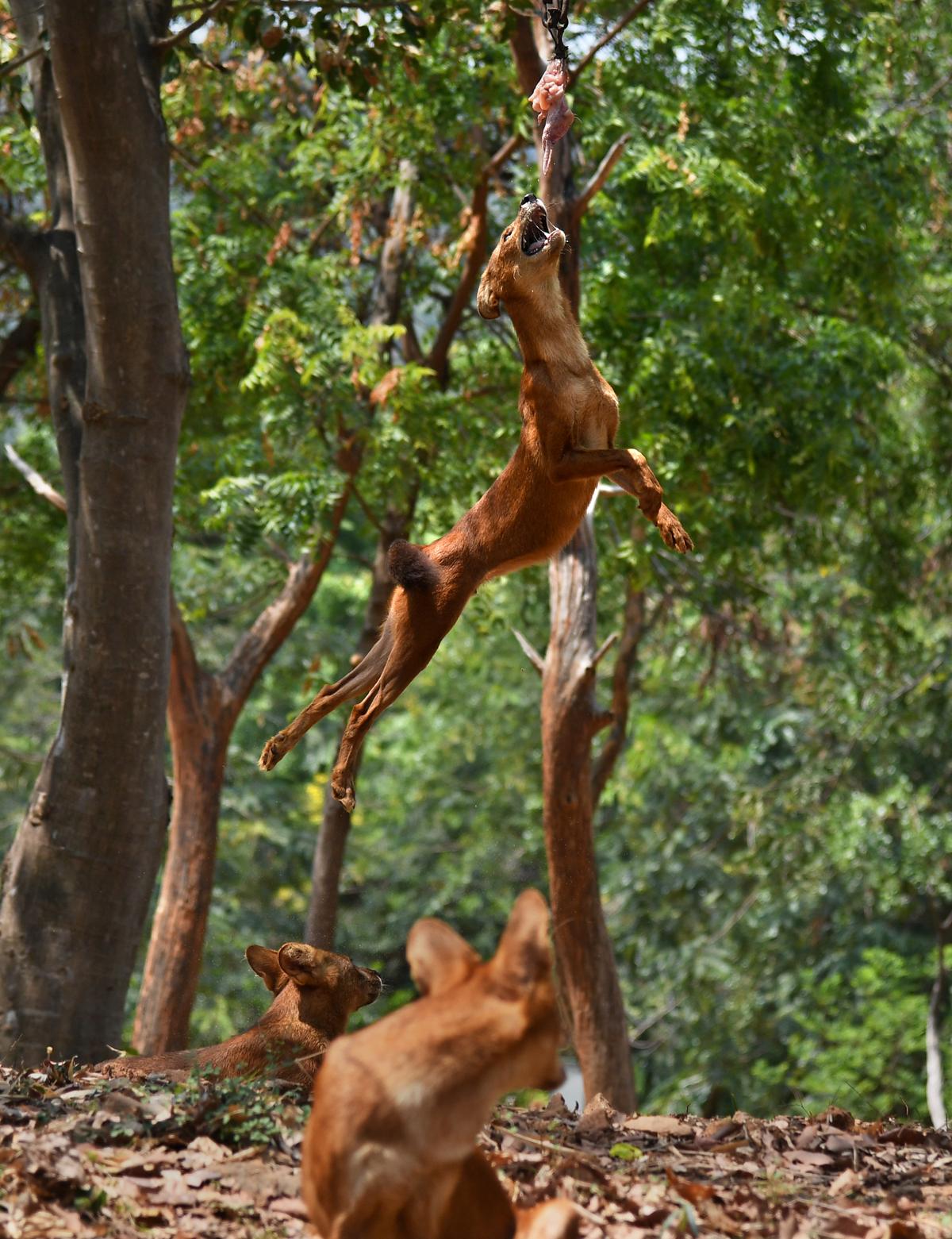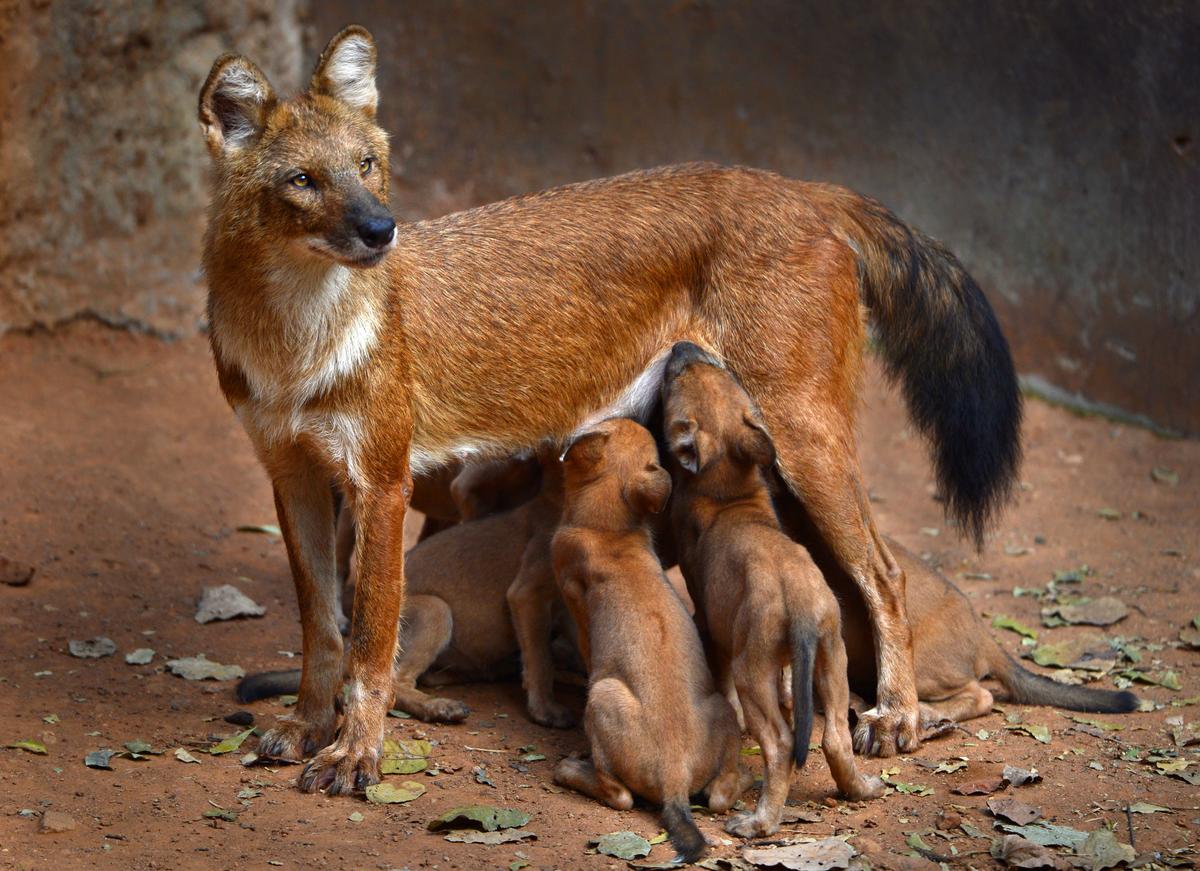As dawn breaks over the Eastern Ghats, the rustle of leaves and bird calls merge with a flurry of movement inside the Indira Gandhi Zoological Park in Visakhapatnam. Away from public view in a quiet, forested space of the zoo lies India’s only conservation breeding centre for the endangered Asiatic wild dog, also known as the dhole (Cuon alpinus).
The breeding season has begun, a time of heightened activity and calm. The rust-red dholes, lithe and full of kinetic energy, dart and leap across their large enclosures. Their piercing eyes scan every movement. “They’re incredibly alert, agile and difficult to restrain,” says Dr Bhanu, the zoo’s veterinarian. “Administering vaccines or medical aid is only possible through a blowpipe, due to their fidgety and skittish nature.”
By 8am, animal keeper Chinna arrives, clutching a thick notebook, his log of daily observations. The dholes recognise his presence, as if wired to an internal clock that alerts them it’s feeding time. Among the 40 dholes currently housed at the centre, including 16 pups, a few potential breeding pairs have been identified. “We first allow the pair to get used to each other’s presence by keeping them close, but separated by a partition in the night kraal for two to three weeks,” explains Dr Bhanu. “If no signs of aggression appear, they’re moved into the day kraal together.”
The mating ritual is brief, lasting just three to five days. Once pregnant, the female enters a 62 to 63-day gestation period. About three weeks before delivery, she begins exhibiting denning behaviour, a clear signal for keepers to prepare. “A quiet, undisturbed environment is critical,” says G Mangamma, curator of the Indira Gandhi Zoological Park. “That’s why our breeding centre is off-display. We’ve also designed four dens that closely mimic wild dens with natural cover.”
The breeding journey of dholes at Visakhapatnam Zoo began three decades ago. In 1992 and again in 1994, wild dholes from the Eastern Ghats, one male and five cubs, were inadvertently trapped in open moats and retained by the zoo authorities. Over the years, through careful pairing and observation, they grew the stock into a small but genetically valuable population. A key milestone came in December 2006, when the alpha female gave birth to nine pups, a record litter at the time.
Commprehensive mission

Visitors going around the newly refurbished look of Indira Gandhi Zoological Park in Visakhapatnam.
| Photo Credit:
KR Deepak
Since then, Visakhapatnam’s facility has become a national hub for dhole conservation. In 2006, the Central Zoo Authority sanctioned a Small Grants Fellowship to initiate in-depth research into dhole reproduction and behaviour under the leadership of then curator B Vijay Kumar. Today, the centre operates with a comprehensive mission to breed dholes in captivity, maintain a healthy gene pool, and contribute to global understanding of this elusive canid.
Dholes are known for their complex social structures. Unlike solitary predators, they live and breed in packs with a strong hierarchy. “Successful breeding happens in stable groups,” says Mangamma. “Single-pair enclosures rarely work, so we are collaborating with other zoos like Nehru Zoological Park Hyderabad, Arignar Anna Zoological Park Vandalur and Sri Venkateswara Zoological Park Tirupati to establish social groups and bring in new genetic material.”

Visitors going around the newly refurbished look of Indira Gandhi Zoological Park in Visakhapatnam.
| Photo Credit:
KR Deepak
The breeding enclosures themselves are thoughtfully constructed, sprawled across 2,662 square metres, lined with native trees like jamun, neem, and bamboo. There are shaded patches, water pools, sunlit clearings and enough space for the animals to express their natural behaviour. Dholes here can leap, play, rest and dig, just as they would in the wild.
Post-partum, the mother is rarely seen, emerging briefly for food or to check for predators. Keepers observe from a distance to minimise stress. “Sometimes, if a pup is born weak or the mother feels threatened, she may kill her own young,” says Mangamma. “This is a known behaviour in carnivores. It’s a survival strategy.”
Challenges

An Indian wild dog or ‘dhole’ jumps to take his feed at its enclosure in the Indira Gandhi Zoological Park in Visakhapatnam.
| Photo Credit:
KR Deepak
Despite its successes, the breeding centre faces several challenges: the small founder population, genetic bottlenecks and limited proven breeders. To address these, the zoo plans a series of research and collaborative initiatives. If supported by the Central Zoo Authority, future studies will include faecal DNA analysis for genetic profiling, development of dhole ethograms (behavioral blueprints), restraint protocols to reduce capture stress and enhanced inter-zoo data sharing networks.
The ultimate goal? “To create a genetically diverse, behaviourally sound captive population that can serve as a source for potential reintroductions into protected wild habitats,” explains curator Mangamma.
Each dhole at the breeding centre is tagged using non-toxic dyes or ear tags. Individual histories are meticulously recorded, from medical records to breeding logs. A technical assistant and biologist have been engaged to maintain animal history sheets and studbooks, forming the backbone of the breeding programme’s scientific documentation.
“There’s still so much we don’t know about dhole biology,” says Mangamma. “Our data collection will help fill the gaps from mating rituals to pup development.”

A wild dog with the fresh litter at Indira Gandhi Zoological Park in Visakhapatnam.
| Photo Credit:
KR Deepak
Conservation breeding is more than a numbers game. “It’s a long-term commitment to understanding and protecting a species,” she adds. Dholes face mounting threats in the wild. “Shrinking prey base, habitat loss and increasing human conflict are some of them. Captive breeding provides a safety net, but it also serves as a living laboratory to deepen our understanding of the species,” says zoo biologist G Purushottam.
The Indira Gandhi Zoological Park is poised to become a referral centre for dhole conservation in India. With support from wildlife institutes like Wildlife Institute of India Dehradun and LACONES Hyderabad and from government and academic institutions, this off-display sanctuary for the wild dogs has the potential to become the heart of dhole conservation efforts in the subcontinent.
Published – June 11, 2025 05:42 pm IST
Source:https://www.thehindu.com/sci-tech/energy-and-environment/asiatic-wild-dog-reviving-indias-elusive-predator/article69628441.ece

